Why you should use untreated wool for your next project
It feels like yarn has come full circle. Before superwash, before acrylics, most yarn was produced from untreated wool. But by the time I was a child in the seventies in my grandmother's "wool" shop there was hardly a natural fiber to be found. Acrylic ruled: customers said that wool was too scratchy for their children to wear and too difficult to wash.
The wool industry fought back with machine-washable wool and superfine, supersoft merinos. Wool was back, with some help from chemical processing. And now the untreated, single-breed yarns are making a comeback too. But what's the benefit, why choose untreated wool?
Untreated wool keeps you warmer than superwash wools. I used to think that my sweaters couldn't keep me warm outside, especially when it's windy. That was until I forgot my coat on a late November trip to a seaside town here in the UK. What I did have was my Rogue sweater, knitted in Rowan Magpie Tweed, a lofty, untreated wool which I'd knit at a snug gauge. Walking towards the wind-whipped beach, wearing my sweater and wondering how many minutes I could last the weather, I began to realize that the cold wasn't getting through; I was warm!

Why is untreated wool warmer? Wool fibers all trap air in their core, but the smooth, sleek fibers of scale-less, resin-coated superwash wool can't hold onto the air between the fibers as well as the rougher, jumbled fibers of untreated wool. The scales help them hold tight to their neighboring fibers, keeping the warmth in and the cold out. I'd always wondered how fishermen, in their highly textured knitted ganseys, didn't die of exposure!
There's something for everyone. From kitten-soft to rough as a scourer, matt to lustrous, clearly defined stitches to blurred and cohesive, hazy to hairless, dense to drapy: wool has it all. The length, diameter, shape and scales of the sheep's fibers vary by breed. All these factors interact to produce a whole heap of variation to choose from.
It's fantastic for colorwork. Wool fibers resist the formation of gaps between color changes, in part due to their elasticity. The wool fibers are stretched as you knit, but their internal structure works to pull them back to their original shape. This leaves the fabric under a tension which reduces the gaps. Add in the scales on the outside of the fibers, which catch against each other and hold neighboring fibers together, and you have a fabric which is far more forgiving of inconsistent tension or over-long fair-isle floats than a smooth fiber.
You can have more control over who gets your money. Producers of single-breed yarns tend to be small businesses. Some of them keep their own flocks or often they can tell you where the wool for each batch of yarn comes from. I'm not anti big-business, I believe we have it to thank for much that's good about the modern world. But that doesn't stop me wanting to support small businesses too! Plus I know that my purchases are promoting diversity by supporting lesser-known breeds.
Yes, but...
Don't they shrink unless you hand wash them? I make a lot of squares as I'm trying yarns out for YarnSub, and many of them have been put through the hand wash cycle in my washing machine. So long as I make sure that there aren't long tails of yarn left to thrash about and start felting, and so long as I don't forget to take them out within a couple of hours of the cycle finishing, they come out beautifully. I don't just mean they look okay, I mean they are as improved as they would be if they were lovingly washed by hand in the sink. They don't need to be dried in the folds of a towel as you would after washing in the sink either. They're ready to be pinned out. If you're not sure if you can trust the hand wash cycle on your machine, just knit a swatch and try it out. (But yes, if your untreated wool gets into any other wash cycle by mistake, it will almost certainly be ruined.)
Isn't untreated wool itchy? It is true that when you see a wool described as a 'rug yarn', then it might be best avoided unless you have some pots to scrub! Or a rug to make. But the fibers of different breeds have a wide range of diameters, and the finer the fiber the more likely it is to yield against your skin and so feel soft rather than prickling it. Look for the fiber that matches the needs of your project. And if you do need soft wool, it's not just Merino sheep that you can turn to. Blue Faced Leicester, Cormo, Corriedale, Falkland, Peruvian Highland, Polwarth and Rambouillet are all breeds that produce very soft wools. Plus many of the big brand untreated wools, which don't specify a breed, are very soft - but with more body than a superwash yarn and less of a soapy feel.
What if my next project is for a newborn baby? Okay, when I was a new mum I could hardly separate my washing into whites and colors let alone think about the hand wash setting on my machine. I admit in this case there's a good argument for choosing something machine washable!
New mothers aside, as well as the practical reasons for using untreated wool, it's the stories behind it that keep me intrigued. Few of us need to knit now (except perhaps for our sanity). The garments that we make are more than just a hat or sweater, more even than a soft hug for their recipient. They remind us of what was passing in our lives as we worked their stitches and they are proof of our capacity for loyalty and dedication to a task. I love the emotional aspect of knitting - and breed-specific wools almost always come with a back-story that enhances the experience. I love knowing that by using a particular yarn I've become part of the story too.
Want to know more?
Try...
- The Knitter's Book of Wool by Clara Parkes
- The Fleece & Fiber Sourcebook by Debbie Robson
- Pure Wool: A Guide To Using Single Breed Yarns by Sue Blacker
And YarnSub couldn't be complete without some information on single breed wools, so I'll be creating and updating a reference page here too.
Yarn Review : Blacker Yarns Cornish Tin
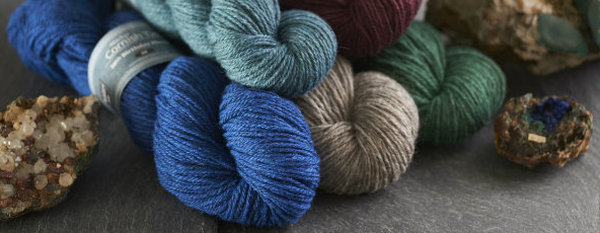
If you're looking for another reason to use untreated wool for your next project, look no further than Blacker Yarns' new Cornish Tin [UPDATE: Unfortunately this yarn is no longer available]. It's been released as a celebration of their 10th Anniversary and is available in both 4-ply (fingering) and DK weights.
They've included fiber from eight different sheep breeds plus alpaca and mohair, so ten fibers for their ten years!
Based in Cornwall in the UK, Blacker Yarns sourced all the fibers for this yarn from within 100 miles of their mill and dyed them to match colors of minerals found in local tin mines.
Yarn Spec
Both weights:
Fiber content - 20% Alpaca, 10% Mohair, 70% Wool (Falklands Merino, English Merino, Gotland, Jacob, Shetland, Black Welsh Mountain, Texel, Gotland/Romney cross)
Washing instructions - Hand wash, do not tumble, cool iron
4-ply (Fingering) weight:
Texture - 2 ply
Gauge - 28 sts and 30 rows/10cm
Recommended needles - 3mm
Meterage - 350m in 100g
DK weight:
Texture - plied, 3 ply
Gauge - 20 sts and 30 rows/10cm
Recommended needles - 4mm
Meterage - 220m in 100g
First impressions
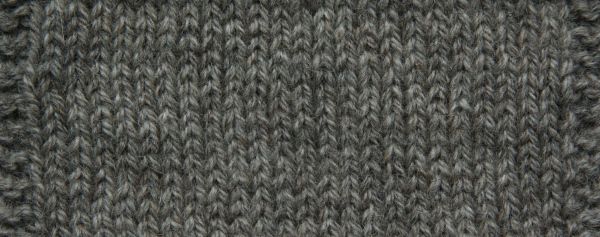
Cornish Tin is soft and lofty with just a hint of crispness. There's a sheen to the fibers and a gentle silky haze. With so many fibers present it's difficult to work out the contributions from the different breeds, but the overall effect is closer to a Jacob/Gotland wool rather than the matt plumpness of an untreated Shetland/Merino wool. The natural colors of the fibers blend to give a heathered finish which I love.
What's it like to knit with?
The high wool percentage makes for a springy yarn which is forgiving about the inconsistenties in my tension. It's been woollen spun and all those jumbled up fibers are keen to take up their own space. To explore this I swatched the 4-ply on 4mm needles once I'd tried it on the recommended 3mm. The fabric was still cohesive, with only the first hints of gapping between the stitches. On 3mm, the fabric was of course a little firmer, but not even close to unyielding. I'm thinking it would be very effective at keeping out the cold!
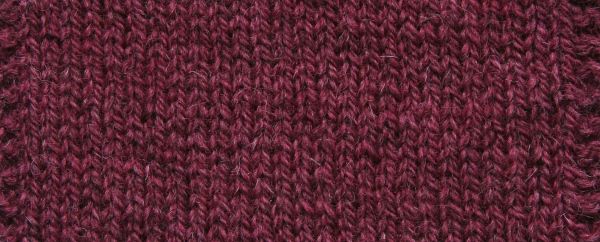
This lace pattern worked well in the 4-ply, though that propensity to take up space might mean that you want to experiment with your needle size if you're after a daintier look and feel.
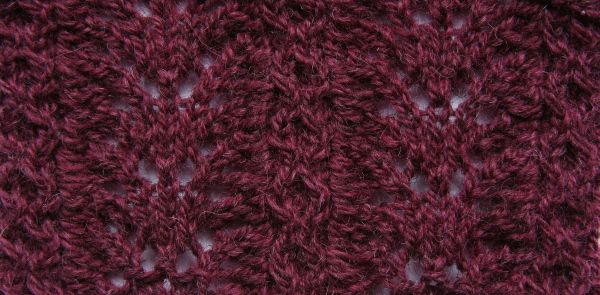
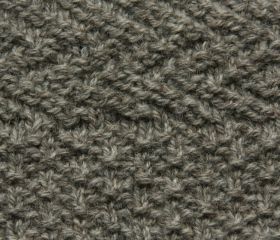
On the other hand, knit and purl textured stitches did not stand out crisply and got lost within the yarn's haze and heathered coloring.
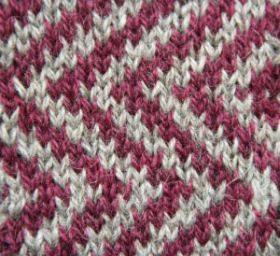 For colorwork, this yarn is outstanding, though your ambitions might be thwarted by the relatively limited color palette. The loft and elasticity made for a pleasing fair-isle swatch which I loved knitting and I only stopped because I ran out of yarn!
For colorwork, this yarn is outstanding, though your ambitions might be thwarted by the relatively limited color palette. The loft and elasticity made for a pleasing fair-isle swatch which I loved knitting and I only stopped because I ran out of yarn!
Does it wash well?
I blocked my swatches initially after a soak in the sink in tepid water. The feel of the fabric was improved as it always is by blocking, though there wasn't a transformative 'bloom'. That's not a negative - the fabric was already good before washing and blocking.
I then added them into a pile of other swatches for a turn in the hand wash cycle of my washing machine and they came out in just as good condition as they went in.
Does it pill?
Performing the pill test on a pristine swatch (by vigorously and repeatedly rubbing it between my knuckles until my hands start to burn) is always a bit distressing; it doesn't seem right to treat knitting that way. With Cornish Tin however, it did more damage to my hands than the fabric! Some fibers did gather on the surface and start to pill and there was some distortion of the fabric, but the excess fiber was easily pulled away and the fabric was tugged back into shape without a problem.
Does it pass the prickle test?
It depends who you're asking. My skin is more robust than average when it comes to prickle and having worn a swatch inside my sleeve for an hour or so, I know I could wear a sweater made from Cornish Tin with just a t-shirt underneath and hardly know I was wearing it. I also tried a swatch against my neck: I could feel it and there was the odd prickle. That means that those more sensitive to prickle might have problems wearing it anywhere directly against their skin and might be best to plan for an outerwear project.
What is it good for?
I can see Cornish Tin used for a sweater with a fair-isle yoke in either the DK or 4-ply weights. Or the DK weight especially would make a great hat - maybe with a sprinkling of colorwork. I can also imagine the DK weight, in the undyed grey perhaps, as an all-over lace cardigan. It would be a sturdy kind of lace, but wonderful.
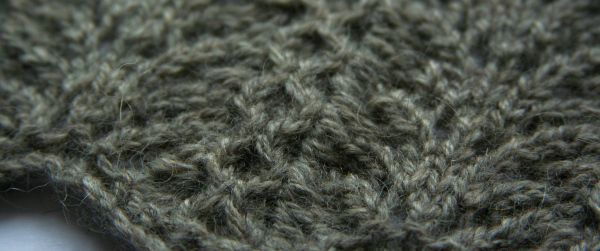
What is it not good for?
Knit and purl texture patterns would be indistinct, save for something like a plain rib. Cornish Tin would make a durable heirloom baby blanket, but I wouldn't gift it as baby clothes or as a scarf (even for an adult) since most people's expectation for these items now is for something very soft. Plus you'd have to trust any person you gave it to not to just throw it in the machine on a normal wash.
Finally...
This is a limited edition yarn available from mid September and Blacker Yarns say they're only making it once. So if you want to try it, don't hang around. Would I use it? Absolutely yes.
Full Disclosure – I received sample skeins of Cornish Tin. There are no affiliate or advertising links to it on YarnSub, and I am not making money from this review.
New and Discontinued Yarns
New
Erika Knight for John Lewis
Aran
– Aran
– 100% Wool
– Plied
– Solid colors
Filatura Di Crosa
Astakan
– Super Bulky
– 52% Wool, 48% Acrylic
– Bouclé
– Solid colors, Multi-colored
Baffo
– Super Bulky
– 50% Mohair, 40% Acrylic, 10% Wool
– Fuzzy
– Multi-colored
Colorino
– Bulky
– 100% Wool
– Single ply
– Self-striping marls
Fleece Artist
BFL Sport
– Sport
– 100% Blue Faced Leicester Wool
– Plied
– Solid colors, Semi-solids, Multi-colored
Wensley Loop
– Super Bulky
– 100% Wensleydale Wool
– Bouclé
– Solid colors, Semi-solids, Multi-colored
GGH
Contino
– Heavy Worsted
– 55% Merino Wool, 30% Acrylic, 15% Alpaca
– Plied
– Solid colors, Marls, Heathers
Kilana
– Bulky
– 60% Wool, 20% Viscose, 20% Nylon
– Tweedy
– Tweed colors
Lacy
– Lace
– 80% Merino Wool, 20% Silk
– Single ply
– Solid colors
Tessina
– Super Bulky
– 53% Wool, 47% Acrylic
– Thick and thin
– Tonal colors
Volante
– Worsted
– 55% Merino Superwash Wool, 45% Cotton
– S on S plied
– Solid colors
Lana Grossa
3 Cento
– Fingering
– 53% Superwash Wool, 47% Acrylic
– Single ply
– Self-striping (gradient)
365 Garzato
– Heavy Worsted
– 46% Cotton, 22% Nylon, 17% Alpaca, 15% Wool
– Fuzzy
– Semi-solid colors
Alta Moda Cashmere 16
– Bulky
– 78% Merino Wool, 12% Cashmere, 10% Nylon
– Chained
– Solid colors, Heathers, Self-striping (gradient)
Alta Moda Super Baby Stella
– Bulky
– 60% Wool, 25% Alpaca, 10% Nylon, 5% Metallic
– Chained
– Heathers with metallic thread
Ambiente
– Super Bulky
– 70% Merino Wool, 30% Alpaca
– Single ply
– Solid colors
Ariosa
– Aran
– 48% Merino Wool, 30% Alpaca, 22% Nylon
– Chained
– Solid colors
Ascot
– Aran
– 57% Superwash Wool, 25% Viscose, 18% Alpaca
– Plied with a soft haze
– Tweed colors
Bingo Alpaca
– Bulky
– 70% Merino Superwash Wool, 30% Alpaca
– Plied
– Self-striping marls
Bombolino
– Heavy Worsted
– 35% Alpaca, 25% Mohair, 25% Wool, 15% Nylon
– Bouclé
– Self-striping (gradient)
Colorato
– Heavy Worsted
– 87% Merino Wool, 13% Nylon
– Chained
– Self-striping (gradient)
Cool Wool Cashmere
– DK
– 90% Merino Wool, 10% Cashmere
– Plied
– Solid colors
Dito
– Heavy Worsted
– 44% Nylon, 28% Alpaca, 28% Mohair
– Fuzzy
– Solid colors
Dito Paillettes
– Heavy Worsted
– 54% Nylon, 19% Alpaca, 19% Mohair, 8% Polyester
– Fuzzy with sequins
– Solid colors with sequins
Hairy (lala Berlin)
– Super Bulky
– 42% Acrylic, 37% Alpaca, 14% Wool, 7% Nylon
– Fuzzy
– Solid colors
Lace Seta
– Lace
– 70% Alpaca, 30% Silk
– Plied with a soft haze
– Solid colors, Self-striping (gradient)
Lupo
– Bulky
– 34% Acrylic, 32% Nylon, 17% Alpaca, 17% Wool
– Faux fur
– Solid colors
Mille II Lux
– Super Bulky
– 48% Acrylic, 48% Merino Superwash Wool, 4% Metallic
– S on S plied
– Solid colors with metallic thread
Ragazza Amici Due
– Super Bulky
– 51% Superwash Wool, 49% Acrylic
– Chained
– Multi-colored
Ragazza Amici Uno
– Bulky
– 51% Superwash Wool, 49% Acrylic
– Single ply
– Multi-colored
Ragazza Twist
– Bulky
– 78% Superwash Wool, 22% Nylon
– Single wrapped with thread
– Self-striping (gradient)
Softness (lala Berlin)
– Super Bulky
– 40% Wool, 40% Nylon, 20% Mohair
– Tape
– Solid colors, Semi-solids
Madelinetosh
Silk Merino
– DK
– 50% Mulberry Silk, 50% Merino Superwash Wool
– Plied
– Semi-solid colors, Multi-colored
Novita
Ruska
– Bulky
– 70% Acrylic, 30% Superwash Wool
– Single ply
– Self-striping marls
Purl Soho
Lanecardate Feltro
– Super Bulky
– 75% Wool, 25% Angora
– Plied with a soft haze
– Solid colors
Rauma
Pelana
– DK
– 50% Merino Wool, 50% Cotton
– Plied
– Solid colors
Red Heart
Boutique Boulevard
– Super Bulky
– 73% Acrylic, 16% Nylon, 11% Superwash Wool
– Filled tube
– Heathered colors
Mixology
– Super Bulky
– 100% Acrylic
– Plied
– Solid colors, Multi-colored
Mixology Swirl
– Super Bulky
– 98% Acrylic, 2% Polyester
– Bouclé
– Multi-colored
Rico Design
Essentials Alpaca Blend Chunky
– Bulky
– 50% Acrylic, 30% Wool, 20% Alpaca
– Plied
– Solid colors
Essentials Mohair
– Super Bulky
– 73% Mohair, 22% Superwash Wool, 5% Nylon
– Fuzzy
– Solid colors
Fashion Artisan
– Super Bulky
– 66% Acrylic, 30% Superwash Wool, 4% Nylon
– Single wrapped with thread
– Multi-colored
Fashion Bouclé
– Super Bulky
– 67% Acrylic, 15% Wool, 9% Nylon, 7% Alpaca, 2% Elastic
– Bouclé
– Solid colors
Fashion Elements
– Super Bulky
– 59% Superwash Wool, 40% Acrylic, 1% Polyester
– Single wrapped with thread
– Marls
Fashion Inuit
– Super Bulky
– 50% Wool, 45% Acrylic, 5% Nylon
– Bouclé
– Marls
Fashion Star
– Super Bulky
– 76% Acrylic, 15% Polyester, 9% Superwash Wool
– Chained
– Solid colors with metallic
Shibui Knits
Dune
– DK
– 50% Baby Alpaca, 25% Camel, 25% Silk
– Plied with a soft haze
– Solid colors
Valley Yarns
6/2 Cotton
– Lace
– 100% Cotton
– 2 plies
– Solid colors
Discontinued
Bendigo Woollen Mills
Fireside
– DK
– 86% Wool, 10% Mohair, 4% Bamboo
– Crepe
– Solid colors
DMC
Cottage Style Camilla
– Bulky
– 40% Superwash Wool, 30% Acrylic, 30% Polyester
– Tweedy
– Tweeds
Metal Chic Belinda
– Bulky
– 70% Superwash Wool, 20% Bamboo, 10% Linen
– Single wrapped with thread
– Heathers
DROPS Design
DROPS Loves You 4
– Aran
– 55% Alpaca, 40% Wool, 5% Linen
– Plied
Filatura Di Crosa
Galaxy
– Bulky
– 68% Acrylic, 14% Polyester, 10% Mohair, 8% Wool
– Fuzzy with sequins
– Solid colors with metallic thread
Frog Tree Frog Tree Yarns closed in August 2015
Alpaca Chunky
– Bulky
– 100% Alpaca
– Plied with a soft haze
Alpaca Sportweight
– Sport
– 100% Alpaca
– 2 plies
Ewetopia
– DK
– 100% Merino Wool
– Plied
Llambrosia
– Sport
– 100% Llama
– Plied with a soft haze
– Heathers
Meriboo
– DK
– 70% Merino Wool, 30% Bamboo
– Plied
Merino Melange
– Worsted
– 100% Merino Wool
– Plied
Pediboo
– Sport
– 80% Merino Superwash Wool, 20% Bamboo
– Plied
Pediboo Worsted
– Worsted
– 80% Merino Wool, 20% Bamboo
– Plied
Picoboo
– Sport
– 60% Cotton, 40% Bamboo
– Plied
Lana Grossa
Feltro Carnevale
– Super Bulky
– 73% Wool, 20% Acrylic, 7% Nylon
– Thick and thin
– Marls
Pashmina
– Worsted
– 78% Merino Wool, 22% Cashmere
– Plied
Lion Brand
Da Vinci
– Super Bulky
– 53% Wool, 47% Acrylic
– Single ply
– Self-striping
Rico Design
Fashion Summer
– Super Bulky
– 100% Cotton
– Tape
– Solid colors, Spray dyed
Sandnes Garn
Kitten Mohair
– Worsted
– 50% Acrylic, 30% Mohair, 20% Wool
– Fuzzy
– Solid colors
Valley Yarns
Northampton Bulky
– Super Bulky
– 100% Wool
– Plied
– Solid colors
Disclaimer: YarnSub provides information for guidance only and doesn't guarantee its accuracy. We try hard to get it right though - please let us know if you see any issues. (hello@yarnsub.com)
